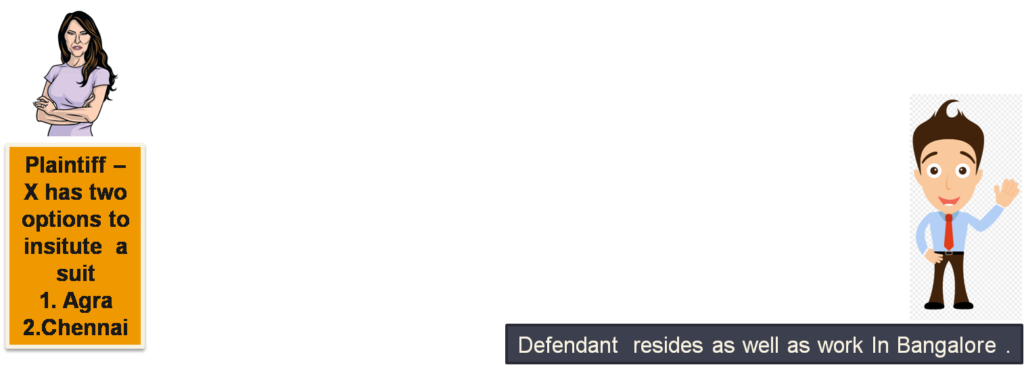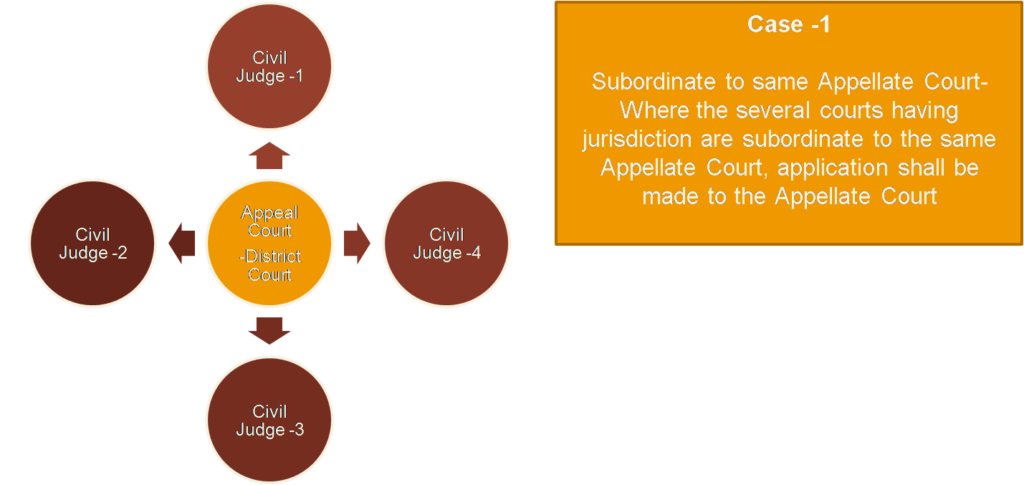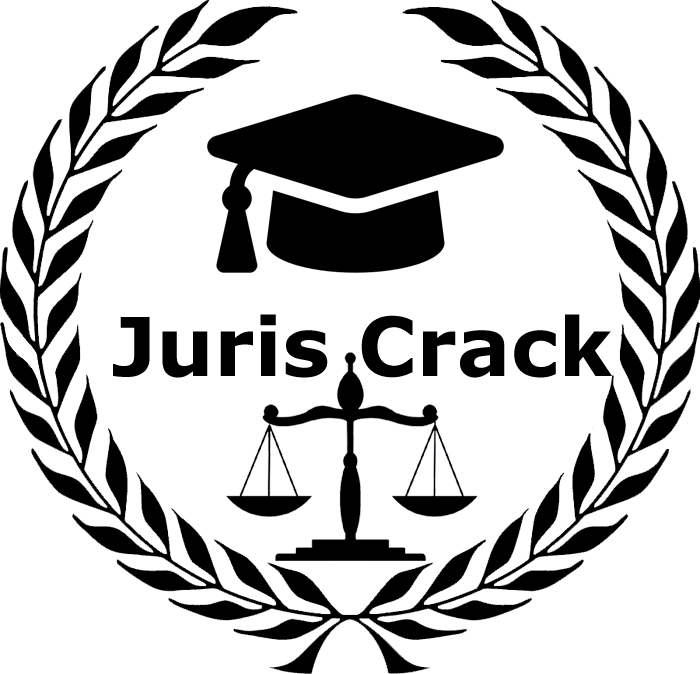Transfer Of Suits
Sec 22,23,24,25 of CPC, 1908
Section 22 & 23 are concerned with a case where the plaintiff has the choice of two or more courts in which he may properly institute a suit. They deal with the right of a defendant to apply to a court to have the case transferred from the court in which it is filed to another court and postulates that the several courts concerned shall have jurisdiction.
Under section 24 & 25 , an application for transfer can be made by any of the parties to a suit , appeal or other proceedings. Section 24 deals with the General Power of a High Court or a District Court to either transfer or withdraw any suit etc, and Section 25 deals with the power of the Supreme Court to transfer any pending suit etc on the application of any of the parties.
Concept Of Dominus Litis/ Arbiter Litis in India
Dominus Litis is a legal maxim, used in India, with the following meaning: The principal in a suit. The controller of a suit or litigation plaintiff is the dominus litis. He is not bound to sue every possible adverse claimant in the same suit and he may choose to implead only those persons as defendants against whom he wishes to proceed. But the Court may at any stage of the suit direct addition of parties. A party can be joined as defendant even though the plaintiff does not think that he has any cause of action against him. [Ramesh Hirachand Kundanmal v. Municipal Corpn. [1992] 2 SCC 524].)]
As a general rule, the plaintiff as arbiter litis or dominus litis has a right to choose his/her own forum where there is more than one Court in which such suit may be instituted. Normally, the defendant cannot insist that instead of Court A, the plaintiff should file a suit in Court B. But the right of the plaintiff to choose a forum is not arbitrary, absolute or uncontrolled and in appropriate cases, a superior Court may transfer a case pending in one Court to another Court.
If the ends of justice so demand, the case may be trans- ferred under this provision notwithstanding the right of dominus litus to choose the forum and considerations of plaintiff’s convenience, etc. cannot eclipse the requirement of justice. Justice must be done at all costs, if necessary by the transfer of the case from one Court to another.
Supreme Court of India In the Case of Dr. Subramaniam Swamy vs Ramakrishna Hegde on 18 October, 1989

Transfer Of Suits
Sec 22,23 of CPC, 1908

CPC Section 22. Power to transfer suits which may be instituted in more than one court .
Where a suit may be instituted in any one of two or more Courts and is instituted in one of such Courts, any defendant, after notice to the other parties, may, at the earliest possible opportunity and in all cases where issues are settled at or before such settlement, apply to have the suit transferred to another Court, and the Court to which such application is made, after considering the objections of the other parties (if any), shall determine in which of the several Courts having jurisdiction the suit shall proceed.
Section 22 provides that the defendant may apply to the court for transfer of suit to another court in case a suit may be instituted in any one of two or more courts. Before transfer is ordered under Section 22, following conditions must be satisfied:
1) Notice is given to the all the parties to the suit.
2) The application must be made at earliest possible opportunity either at before or settlement of issues.
Hearing of Objections:- After Notice is served to the other party, the court must decide that application of transfer after hearing of objections of the opposite party
CPC Section 23. To what court application lies.
(1)Where the several Courts having jurisdiction are subordinate to the same Appellate Court, an application under section 22 shall be made to the Appellate Court.
(2) Where such Courts are subordinate to different Appellate Courts but to the same High Court, the application shall be made to the said High Court.
(3) Where such Courts are subordinate to different High Courts, the application shall be made the High Court within the local limits of whose jurisdiction the Court in which the suit is brought is situate.
This Section indicates in which court application can be made:
1.Subordinate to same Appellate Court- Where the several courts having jurisdiction are subordinate to the same Appellate Court, application shall be made to the Appellate Court.
2. Subordinate to different High Court- Where such courts are subordinate to different Appellate Court, but to the same High Court, the application shall be made to the said High Court.
3.Subordinate to different High Courts- Where such courts are subordinate to different High Courts, the application shall be made to the High Court within the local limits of whose jurisdiction the court in which the proceedings first commenced is situated.
This is called First Commencement Rule.
Section 22 And 23 are complementary to each other . While Section 22 permits the defendants to apply for a transfer , Sec -23 specifies the court to which the application should be made.
It is found in Sections 22 to 25 of the Code and those provisions are exhaustive in nature. Whereas Sections 22, 24 and 25 deal with power of transfer, Section 23 merely provides forum and specifies the Court in which an application for transfer may be made. Section 23 is not a substantive provision vesting power in a particular Court to order transfer.



Durgesh Sharma vs Jayshree , 2008
Supreme Court of India In the case of Durgesh Sharma vs Jayshree face with issue of transfer of suit from one High Court to other High Court
A short but interesting question of law has been raised before this Court in the present appeal as to the power, authority and jurisdiction to transfer suits/appeals/other proceedings by a High Court from one Court subordinate to it to another Court subordinate to another High Court.
Facts of the Case.
The applicant Durgesh Sharma is the husband of the respondent Smt. Jayshree Sharma. Marriage of the parties was solemnized at Malegaon, District Nasik in the State of Maharashtra on May 16, 1989.
The appellant-husband served a notice through his advocate to the respondent-wife on September 22, 2004 to join him to which a reply was sent by the wife through her counsel on October 08, 2004 wherein false allegations have been levelled against the husband which clearly went to show that she was not prepared to stay with the husband.
Since the respondent-wife did not return matrimonial home, the appellant-husband instituted a petition under Section 13 of the Hindu Marriage Act, 1955 (hereinafter referred to as `the Act’) on October 27, 2004 in the Family Court at Ujjain which was registered as HMA Petition No. 164A of 2004 for dissolution of marriage on the grounds of (i) desertion; and (ii) cruelty. The appellant husband has stated in the petition that both the parties lastly lived together at Ujjain as husband and wife. Ujjain Court has, therefore, jurisdiction to entertain, try and decide the petition.
She also stated that she was staying at Malegaon, District Nasik in Maharashtra which was at a distance of about 400 kms. from the city of Ujjain. Parents of the respondent- wife were very old. Business of her father was closed
Facts of the Case.
She also contended that Ujjain Court had no jurisdiction to entertain, try and decide the petition. A prayer was, therefore, made to dismiss HMA with costs.
It may be stated that the respondent- wife also filed an application under Section 9 of the Act for restitution of conjugal rights in the Court of Civil Judge, Senior Division, Malegaon being HMP No. 42 of 2005 on March 23, 2005.
Immediately thereafter, the wife preferred an application under Section 23 of the Code of Civil Procedure, 1908 (hereinafter referred to as `the Code’) in the High Court of Madhya Pradesh (Indore Bench) for transfer of Ujjain case instituted by the husband being HMA Petition No. 164A of 2004 titled Durgesh Sharma v. Smt. Jayshree Sharma pending in the Family Court at Ujjain to a Court of competent jurisdiction at Malegaon, District Nasik in the State of Maharashtra.
High Court’s Order
The High Court vide the impugned order dated January 25, 2007 allowed the application and transferred HMA 164A of 2004 pending the Family Court, Ujjain to a competent Court at Malegaon through District Judge, Nasik. It is this order which is challenged in the present appeal.
Supreme Court Decision
Since in our considered view, Section 23 is merely a procedural provision, no order of transfer can be made under the said provision. If the case is covered by Section 25 of the Code, it is only that section which will apply for both the purposes, namely, for the purpose of making application and also for the purpose of effecting transfer. On the contrary, reading of sub-section (3) of Section 23 of the Code in the manner suggested by the learned counsel for the respondent-wife would result in allowing inroad and encroachment on the power of this Court not intended by Parliament. Section 23, therefore, in our considered view, must be read subject to Section 25 of the Code. The decisions taking a contrary view do not lay down correct law. We, therefore, overrule them. Even if such power was with a High Court earlier, it stood withdrawn with effect from January 01, 1977 in view of Section 25 of the Code as amended by Code of Civil Procedure (Amendment) Act, 1976.
Governing factor as to rule to transfer of an application under Sections 22 & 23.
1.Balance of convenience is a factor to be look into.
1. Prior notice to the parties i.e. served notice to the parties and it is based on principle of natural justice.








No comment